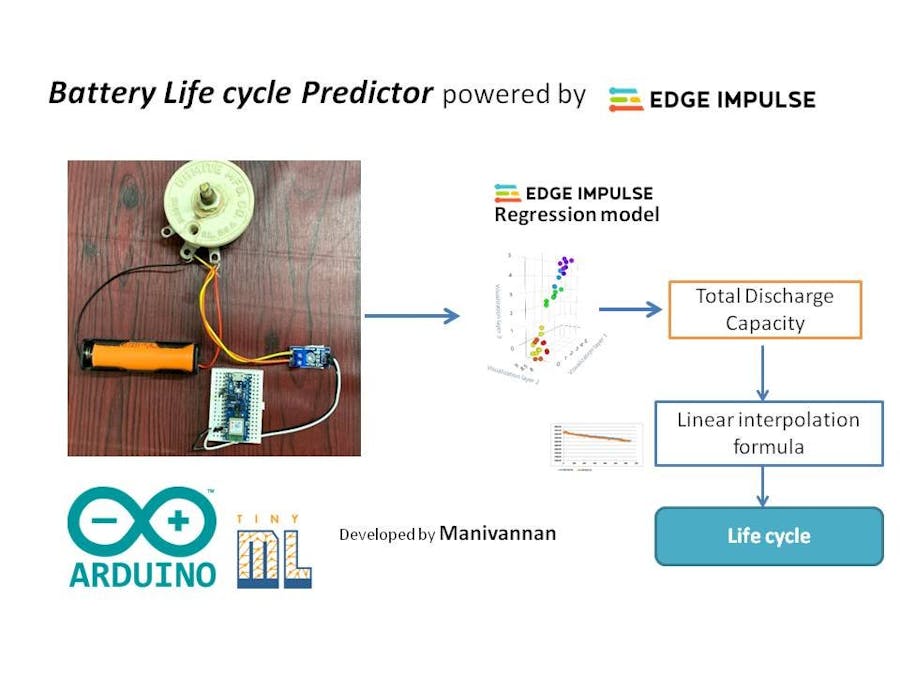Before the detailed documentation, I have attached the demovideo of my project in below YouTube link, Kindly watch it.
To predict the Life cycle of Lithium Ion battery, there are many methods are available. One of the common method is by linear interpolating the discharge capacity to the life cycle.
In a conventional method, To estimate the life cycle using discharge capacity method, it takes 2 hours 30 mins of time for 2500mAh - single Lithium Ion cell.
I developed a TinyML model using Edge impulse based on Linear regression method to predict the life cycle of a battery in 1 hour time period.
This could save 90 mins of time compared to normal conventional method.
Before proceeding with technical work, let's go through the basic specification about Lithium Ion battery.
- The nominal voltage is 3.7v which is the actual voltage of fully charged battery when it is connected to Load.
- The capacity of battery is 2500mAh, So If the battery is discharging at constant current 1A, then it takes 1 hour to discharge 1000mAh and for 2500mAh, it takes 2 hours and 30 mins.
- When the battery discharge voltage reaches 2.75 v, it can be considered as fully discharged.
The Battery Life cycle predictor involves :
1. Battery Voltage reading
2. Simulating different discharge voltage patterns
3. Training the Model
4. Deployment
5. Applications
To read the discharge battery voltage, the voltage sensor is connect parallel to the rheostat. The Rheostat is adjusted in order to set the discharge current as 1 Amps.
Once the rheostat is connected to consume 1A load current, then the voltage reading had been displayed in serial terminal with 1 minute sample time.
Hardware Setup:Code to read Battery voltage:
// Define analog input
#define ANALOG_IN_PIN A0
// Floats for ADC voltage & Input voltage
float adc_voltage = 0.0;
float in_voltage = 0.0;
float cal_temp=0.33;
// Floats for resistor values in divider (in ohms)
float R1 = 30000.0;
float R2 = 7500.0;
// Float for Reference Voltage
float ref_voltage = 5.0;
// Integer for ADC value
int adc_value = 0;
int minute=0;
void setup(){
// Setup Serial Monitor
Serial.begin(115200);
}
void loop(){
// Read the Analog Input
adc_value = analogRead(ANALOG_IN_PIN);
// Determine voltage at ADC input
adc_voltage = (adc_value * ref_voltage) / 1024.0;
// Calculate voltage at divider input
in_voltage = adc_voltage / (R2/(R1+R2));
// Print results to Serial Monitor to 2 decimal places
//Serial.print("Input Voltage = ");
Serial.print(minute);
Serial.print(',');
Serial.println(in_voltage-cal_temp, 2);
minute++;
// Short delay
delay(60000);
}2.1 Save the normal battery discharge data in excel
copy and save the serial monitor data into the excel file as below template. The voltage value should be in second column under 'Y'. The first column is time series. it should be incremented as ( 1) 1000ms.
Step2.2 : Signal builder in Matlab
Create a new Simulink model in Matlab
Then type 'signal builder' in workspace and select it. Also insert
the 'scope' to connect it to the signal builder. Please refer the below screenshot.
Load the battery voltage data in signal builder and edit it according to different life cycle patterns.
Then export the file and copy and save it as csv file.
Once the datasets for different voltage are generated, then upload the csv file in Edge Impulse.
since we are going to train in regression model, The label of a dataset should be numeric one.
In our case, the battery voltage after one hour as a label.
3.1 Create Impulse
In create impulse section, mention 28000ms as window time.
[ 28 minutes data is manipulated as 28 sec data, since we had taken a data in one minute sample time]
Since it is a raw data and regression model, no DSP block is required.
In a generating features, the expected voltage from 2.75 to 2.90 is listed.
2.75v at 2 hour is 2000mAh capacity, where as 2.9v at 2 hour time period is 2500mAh. The linear interpolation can calculate the estimated capacity by predicting the voltage.
Train the model with below settings.
I have tested with two datasets where the 100% accuracy is achieved.
Deploy it as Arduino library.
And include the library in Arduino as library file.
The battery life cycle is predicted by linear interpolating Discharge capacity to the life cycle.
In EI model, the model will predict the estimated battery voltage level after 1 hour. ( at 120th minute). The predicted voltage will be linear interpolated to the discharge capacity as below:
X axis : xo = 2.9, x1=2.75
Y axis : yo= 2500, y1=2000
The predicted discharge capacity can be used to estimate the life cycle.
From specification of 18650 Li ion battery type, the life cycle of battery for discharge capacity is plotted. This will be again linear interpolated to estimate the battery Life cycle.
ApplicationThe reuse of Lithium Ion battery will have huge market demand in future. So this kind of ML model to save the time in predicting the life cycle will create a huge impact in industries.





















Comments
Please log in or sign up to comment.